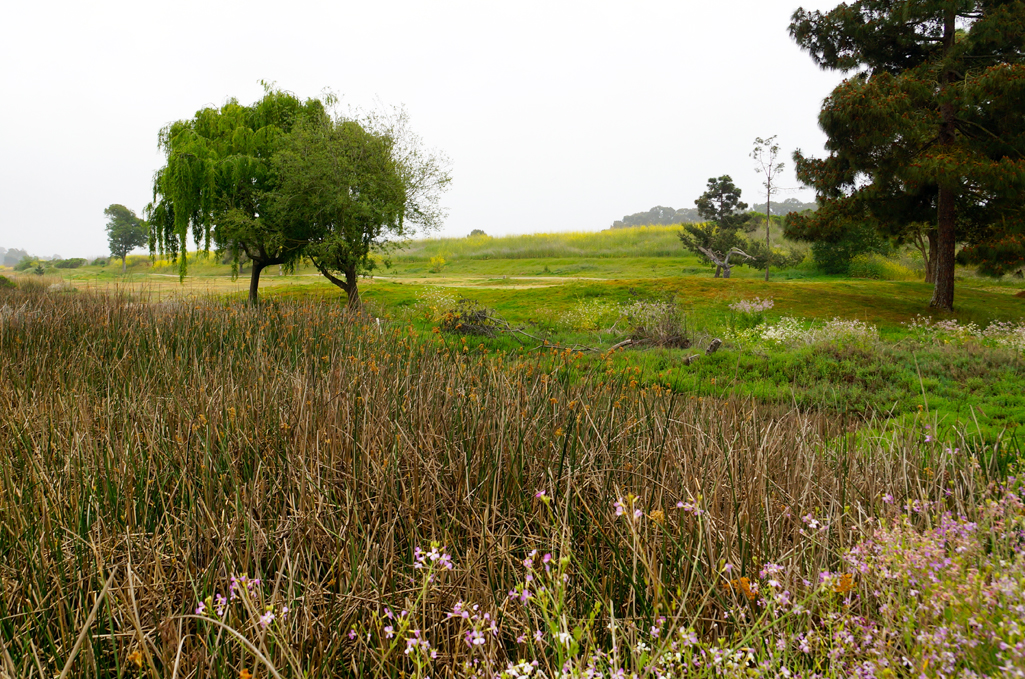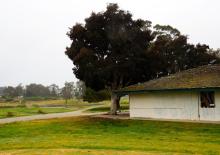
UC Santa Barbara and The Trust for Public Land Partner to Restore Wetlands

With its characteristically large pectoral fins, big pouty mouth, and near-translucent appearance, the tidewater goby is a distinctive fish. Topping out at two inches in length, the California-specific species has been known to frequent several spots in Santa Barbara County.
At least, it had. The goby has been on the endangered species list since 1994.
But the diminutive fish may soon see new habitats created on its behalf, courtesy of a unique partnership between UC Santa Barbara and The Trust for Public Land (TPL).
Aiming to restore and preserve the wetlands on the upper Devereux Slough –– which 50 years ago was filled with topsoil to make way for a golf course –– the pair is teaming to return Ocean Meadows Golf Course to its natural state. The project will ultimately open to the public an expanse of land extending some three miles along the Ellwood Devereux coast in Goleta by connecting several existing preserved properties.
A national leader in raising money for conservation, the nonprofit TPL purchased 63 acres of the now-closed Goleta course with $7 million in grant money. Subsequently gifting the property to UCSB, which will serve as long-term stewards of the land, TPL will also help raise funds for its restoration.
The property's previous owner retained, and plans to develop, a small corner of the 70-acre parcel. The Santa Barbara County Board of Supervisors approved the lot split in August 2012; the California Coastal Commission followed suit in January 2013.
The university will not expend its own public funds, or any of its existing resources, for the project that will feature open space, trails, and boardwalks for public access and passive recreation. The plans also include potentially retrofitting the Ocean Meadows clubhouse into a visitors center to enhance community outreach.
"UC Santa Barbara is pleased to partner with The Trust for Public Land on this worthwhile project," said Chancellor Henry T. Yang. "The UCSB campus is proud of its efforts to acquire and set aside large portions of the Devereux and West Campus bluffs area for reserve and open space. The addition of the Ocean Meadows property will allow us to collectively implement a more inclusive, coherent, and comprehensive management plan for the entire Devereux Slough. We look forward to working together to preserve this beautiful and ecologically important area for education, research, and public enjoyment, now and for generations to come."
Sitting north of the UCSB-owned and operated Coal Oil Point Reserve, the just-acquired parcel connects a string of protected lands along what's known as the gateway to the Gaviota Coast. Its restoration will make it a part of a 650-acre swath of coastal habitats preserved, and opened for public access, in perpetuity.
The Ocean Meadows endeavor puts a sort-of capstone on one of the university's long-range environmental initiatives, according to Duncan Mellichamp, an emeritus professor of engineering at UCSB, and a member of TPL's California Advisory Board. Mellichamp helped shepherd the arrangement to fruition, and will play a similar liaison role throughout the restoration.
"This is an opportunity for the campus –– a chance to finish something that was started back with the Ellwood-Devereux project –– and I'm real pleased about the whole thing," Mellichamp said. "The project will ultimately benefit the community probably more so than the campus, because it will open up access to the public. It makes all the sense in the world to do. And it sure fits the university's triple mission of education, research, and public service."
All three of those priorities will be pursued at Ocean Meadows. Among the groups so engaged will be UCSB's Cheadle Center for Biodiversity and Ecological Restoration (CCBER). Besides helping to develop an overall restoration plan –– and providing expert guidance in such things as local plants, soil types, and habitat creation –– CCBER will use the site for investigation, teaching, and community outreach.
"I see a huge range of outcomes in terms of research," said Carla D'Antonio, CCBER's faculty director. "If the sea level rises a meter in the next century, what does this mean in terms of the absorptive capacity of wetlands now that we'll have an extension to the Devereux Slough? The area already floods. How will that change? How will birds and animals respond to the changes that we put on the landscape?
"These are issues that will take a long time to bear out empirically," she added, "but we can do a lot of modeling and projections and student-based projects that could give insight into those questions."
Such projects could include technical, hydrological, engineering, and biological inquiries, said D'Antonio, including "plant responses, fish responses and the potential for creation of habitats for the endangered tidewater goby."
"It's exciting, but it's going to be slow and careful and carefully done, because this is really a tremendous opportunity that will also improve the quality of the nearby Coal Oil Point Reserve, and the habitat value for animals and plants," D'Antonio said. "This restoration project is really sealing the deal in terms of that eastern edge of the whole Ellwood-Devereux open space region. Taking away the golf course and putting the wetland back really helps homogenize the nature of that area as an intact habitat, instead of having all these interruptions. All the way across Ellwood Mesa to Storke Road will be restored habitat –– it's wonderful."
The culmination of an endeavor it first began in 2008, TPL completed purchase of the Upper Devereux Slough property on March 29. The donation and title transfer to UCSB officially closed on April 30, 2013.
"This property is now part of a 650-acre complex of contiguous protected lands and is permanently protected for use by both people and wildlife," said Alex Size, project manager for TPL. "The Trust for Public Land wants to thank our partners –– the California State Coastal Conservancy and UCSB's Cheadle Center for Biodiversity and Ecological Restoration –– as well as our funders and the many supporters that helped along the way to make this acquisition possible."
Cheering the completion of the deal, Size cited the "years of hard work, including fundraising and navigating a circuitous regulatory process" that have "finally paid off for the public."
Rough estimates peg the cost of restoring the property at around $10 million, according to Chuck Haines, director of capital development in UCSB's budget office. The intent, he said, is to solicit enough grant funds and private donations to cover the total price tag, plus support long-term operation and maintenance.
With a restoration plan still to be developed and approved, work is not likely to begin in earnest for about a year, Haines said. Any necessary public safety fixes will be made right away, and informational signage may be erected soon.
TPL will spearhead fundraising for the overall project, and has already raised almost $2 million, according to Haines. In what will be a multi-phased undertaking, the restoration will be completed in waves, as funding is secured. The university hopes to eventually start, and seek donations for, an endowment to cover ongoing maintenance, he said.
"The purpose is to restore the site to its historic condition and preserve the site in perpetuity, to protect species –– both wildlife and plant life –– and to allow for public access and passive recreation," said Haines. "No construction. No activities other than those related to restoration. Everyone involved is in lockstep with those requirements.
"Those restrictions are recorded in the sale," he added. "They are part of the land and –– for lack of a better term –– they are written in stone. And UCSB will live up to those obligations. We are entering this with our eyes open and intending to be good partners in restoring this property and serving as a steward of it in the long term."
Related Links



